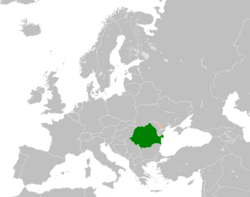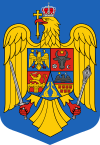Romania–Transnistria relations
 | |
Romania |
Transnistria |
|---|---|
Romania–Transnistria relations are the bilateral relations between the Pridnestrovian Moldavian Republic (PMR; Transnistria), internationally recognized as part of Moldova, and Romania. Romania does not recognize the independence of Transnistria.
During the 1990s, several governments of Romania supported the idea of a unification with Moldova. Many of the proposals would not have included Transnistria.[1] During the Transnistria War, Romania provided Moldova with military support against Transnistria.[2] Additionally, the Romanian foreign ministry was engaged in diplomatic activities to end the hostilities.[3]
In 2010, the Romanian government agreed to participate in the NATO missile defence system. As a reaction, the Transnistrian government suggested a deployment of medium-range 9K720 Iskander missiles in Transnistria.[4] Three years later, experts considered this scenario unlikely.[5]
In 2016, the Press Service of the Foreign Ministry of Transnistria protested against the alleged recurring intrusion of Romanian airplanes into Transnistrian air space.[6]
In 2017, journalists of several Romanian media like România liberă and Digi24 visited Tiraspol and interviewed the Transnistrian foreign minister.[7]
In 2019, Transnistrian president Vadim Krasnoselsky said, that for him, "Ukraine, Russia and Moldova (are) more relevant than Romania".[8]
In Transnistria, Romania is traditionally seen as an antagonist.[9]
In 2013, Romania was Transnistria's third largest export partner.[10] In 2022, two thirds of all Transnistrian exports went to the European Union and most of them to Romania.[11]
See also
[edit]References
[edit]- ^ Pridnestrovien Experts Discuss Topical Issues of PMR’s Foreign Policy, mid.gospmr.org 14 July 2011.
- ^ Adam, Vlad (2017). Romanian involvement in the Transnistrian War (Thesis). Leiden University. pp. 1–31.
- ^ Steven D. Roper: Regionalism in Moldova: The Case of Transnistria and Gagauzia, in: James Hughes/Gwendolyn Sasse (eds.): Ethnicity and Territory in the Former Soviet Union: Regions in Conflict, London: Cass 2002, pp. 101–122 (here: p. 102).
- ^ Marcin Kosienkowski: Continuity and Change in Transnistria's Foreign Policy After the 2011 Presidential Elections, Lublin: The Catholic University of Lublin Publishing House 2012, pp. 25/26.
- ^ Tomasz Dąborowski/Andrzej Wilk: Missile shield in central Europe becoming a reality, osw.waw.pl/en/ 30 October 2013.
- ^ Comment by the Press Service of the Foreign Ministry of the PMR on the facts of unsanctioned intrusion into the airspace of the Pridnestrovian Moldavian Republic, mid.gospmr.org 20 April 2016.
- ^ Vitaly Ignatiev answered the questions of Romanian journalists, mid.gospmr.org 31 March 2017.
- ^ Press conference of the PMR President Vadim Krasnoselsky, en.president.gospmr.org 29 August 2019.
- ^ Andrey Safanov: Transnistria: A Policy of Denial, Containment and Separation from Moldova, in:. Marcin Kosienkowski/William Schreiber: Moldova – Arena of International Influences, Lanham (MD): Lexington Books 2012, pp. 267–272 (here: p. 267).
- ^ Kamil Całus: An aided economy. The characteristics of the Transnistrian economic model, osw.waw.pl/en/ 16 May 2013.
- ^ Diana Scorpan: Over 67% of exports of the Transnistrian region’s exports go to the EU, moldovalive.md 7 February 2023.

